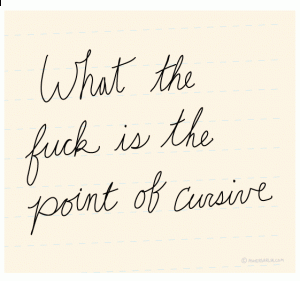 The day I learned to write cursive was the day my handwriting—and probably all semblance of fine motor control over drawing implements—died. It was 1982 or 1983, and I was living in Brighton, England, an 8-year-old temporary American transplant to the British state school system. Until then, I’d learned, as most kids do, to write block letters, and was very comfortable doing so.
The day I learned to write cursive was the day my handwriting—and probably all semblance of fine motor control over drawing implements—died. It was 1982 or 1983, and I was living in Brighton, England, an 8-year-old temporary American transplant to the British state school system. Until then, I’d learned, as most kids do, to write block letters, and was very comfortable doing so.
But in school, they kept trying to teach us some other form of writing: cursive, I guess. I didn’t get it. What was the point?
And then, suddenly, at home one evening, I did. I realized that I could keep my fountain pen (required by the school) on the page and connect the tail of one letter to the beginning of the next. Just like that, I was writing cursive.
Of course, my penmanship was atrocious. And if I’d been any other student, I’m sure my knuckles would’ve been rapped, my hide caned, until I could scrawl like the Queen ‘erself.
But I was an American, and I told my teachers this was how it was done in America. Since I was going back there at the end of the year, they decided not to teach me cursive the right way.
And yet, the next year, when I was home in Massachusetts, I played the same card with my new teachers. My awful cursive penmanship, I said, was the British style. And my gullible instructors bought it. They backed off. I continued to write an illegible cursive that no one—now, not even I—can read.
That same year, however, was the year I discovered computers and began to learn to type, first a speedy hunt-and-peck, much later a structured approach. Pretty soon, I was far more comfortable typing than writing by hand, so much so that my fifth-grade teachers misinterpreted my hatred of the physical act of writing as some weird learning disability, and temporarily placed me in the slow-kids’ English class. That didn’t last long.
I’m reminded of all of this by the local newspaper, which frets in its own special way, over the impending death of cursive:
The sinuous letters of the cursive alphabet, swirled on countless love letters, credit card slips and banners above elementary school chalk boards are going the way of the quill and inkwell. With computer keyboards and smartphones increasingly occupying young fingers, the gradual death of the fancier ABC’s is revealing some unforeseen challenges.
Might people who write only by printing — in block letters, or perhaps with a sloppy, squiggly signature — be more at risk for forgery? Is the development of a fine motor skill thwarted by an aversion to cursive handwriting? And what happens when young people who are not familiar with cursive have to read historical documents like the Constitution?
Guess what, Gray Lady? I have answers!
- Maybe, but might people who write proudly and frequently in cursive be more at risk for computer-based identity theft?
- Yes.
- They read widely available digital versions. Or they puzzle out the documents letter by letter.
To be fair, the article doesn’t spend that much time moping about the death of cursive. Mostly, it’s full of people like this:
“Schools today, we say we’re preparing our kids for the 21st century,” said Jacqueline DeChiaro, the principal of Van Schaick Elementary School in Cohoes, N.Y., who is debating whether to cut cursive. “Is cursive really a 21st-century skill?”
Soon, I predict, writing cursive—indeed, writing by hand at all—will become one of those retro trends that only hipsters engage in, like riding bicycles or eating vegetables. I offer myself as exhibit number 1, for I, in recent years, have found occasional joy in writing things by hand. Now, from time to time, I write in “small caps”: capitals at capitals, lowercase as smaller-font caps. It looks nice, and I can even read what I’ve written.
And, of course, like any writer who dreams of one day publishing a book, I’ve developed a decent signature, sharp and swooping and dramatic. I particularly like signing it on the backs of checks. And so, if you’d like an example, please send me a check. I promise to sign it and return it to you (via your bank) as fast as humanly possible.

I can read most people’s cursives, but I can’t read the computer-generated, half-block, half-cursive security letters. That’s what they need to teach at school
Ugh, I’m losing my cursive. I’ve practiced on ten checks so far! Do you mind if I just send you all of them?
Being able to write a readable cursive and being able to read historical cursive are two completely different things. The latter is called paleography and the fact that it has it’s own name and devoted field of study should tell you something.
Cursive as taught in the US (e.g. Palmer Method, D’Nealian) is an abomination, anyway. The cursive letterforms bear little or no relation to the standard print forms, they’re poorly distinguished from each other, and when written quickly, they degenerate into an illegible scrawl. Much better to learn a proper italic hand from the start. Not quite as fast, but stays legible at all speeds, and if you need to write a whole lot fast, you will be using a keyboard anyway.
Finally RTFA, and I have to agree with Kate, as well. Cursive isn’t one uniform thing that stayed the same over time.
Georgia is obsessed with The Cursive, with Korinne fast on her tail. But then, I used to write typography articles, back in the day, so what would you expect. Long live The Cursive, The Cursive is dead.
I figure I’m just raising future hipsters anyway.